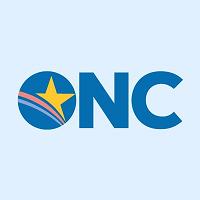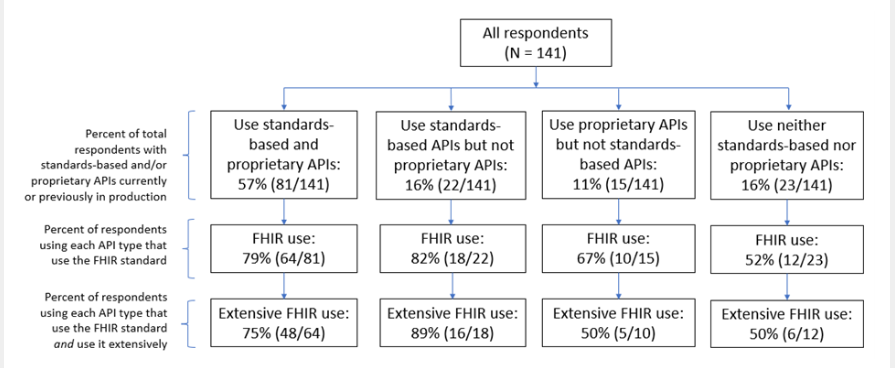 By Wes Barker, Catherine Strawley, and Benjamin Rosner, ONC
By Wes Barker, Catherine Strawley, and Benjamin Rosner, ONC
LinkedIn: Wes Barker
LinkedIn: Catherine Strawley, MPH
LinkedIn: Ben Rosner, MD, PhD
LinkedIn: ONC
New research from a survey of digital health companies shows that most companies (73%) use standards-based application programming interfaces (APIs) when integrating with electronic health records (EHRs) (Figure 1). In 2020, ONC finalized its Cures Act Final Rule, which codified the use of the Health Level 7® (HL7®) Fast Healthcare Interoperability Resources® (FHIR®) standard for “certified APIs” that can enable secure, programmatic access to a patient’s electronic health information (EHI). These certified APIs standardize data connectivity and format requirements so that third-party applications, like smartphone apps, can expect the same functionality and patient data when connecting to any EHR with a certified API.
Figure 1: Digital health company use of APIs and the FHIR standard
Notes: N = 141.
The Cures Act Final Rule required developers of these certified APIs to adopt the FHIR standard and respective implementation guides by December 31, 2022. The survey data, collected prior to the December 2022 deadline, show that not only do most digital health companies who integrate their apps or software with EHRs use the FHIR standard as part of their products, but also that companies who connect with multiple EHRs use these standards-based APIs at higher rates. About 3 in 4 companies with apps integrated with more than one EHR reported extensive use of the FHIR standard, compared to just 1 in 4 companies with apps integrated with one EHR.
What the Data Tell Us
The data not only show high levels of adoption of the FHIR standard among these healthcare technology companies, but also demonstrate that EHR companies implemented these standards-based APIs and made the technology available to third-party users well before the deadline for the certification requirement. Other research has shown that FHIR adoption among EHRs, especially market leading EHRs, was common before and after the finalization of the Cures Act Final Rule, but this new data reveals the wide use of the technology among the intended users – third-party application and software developers. A session at ONC’s Tech Forum, where our study was presented, expounds on this point.
Despite the early success in implementation and use of these FHIR-based APIs, a large portion of companies continue to use other API types. As shown in Figure 1, 57% of companies reported using proprietary APIs alongside standards-based APIs, and 11% reported using proprietary APIs without the use of standards-based APIs. Companies may use APIs of varying types due to persisting challenges with API implementation as well as limited FHIR support for particular use cases. About half of digital health company survey respondents reported high fees, 4 in 10 reported the lack of realistic clinical testing data, and another 4 in 10 reported data elements of little interest or value as substantial barriers to the use and broader utility of the APIs. The results validate other concerns raised by health IT community members, especially app developers and other digital health companies, about the limited scope of the current certified APIs and barriers to entry like fees, data access, and developer support, that affect realization of APIs “without special effort” as called for in the 21st Century Cures Act.
Achieving APIs “Without Special Effort”
ONC projects like Lantern and Inferno strive to improve the resources and data available to digital health companies. ONC’s information blocking regulations reinforce and support a patient’s ability to access their EHI, including through an app of their choice. Furthermore, certain requirements in ONC’s recent HTI-1 final rule aim to resolve some persistent barriers by reducing the effort to use these APIs. Specifically, the final rule revises and standardizes requirements for certified API developers to publish electronic FHIR endpoints and adopts the United States Core Data for Interoperability (USCDI) version 3, which expands the current set of standardized data elements available through certified APIs. These updates make it easier for app developers to connect their users to their data and expands the data set EHRs are required to provide through their certified APIs.
Studies like this enable ONC and its partners to better understand the needs of the community and evaluate the implementation of health IT policies. However, no study is comprehensive enough to understand the experiences of all community members. If you experience a concern or challenge using certified health IT, especially if you are a third-party developer or patient trying to interoperate your app with an EHR, you may submit your concern to ONC’s Health IT Feedback portal. All concerns are carefully reviewed and considered by ONC to inform and improve its policies and programs.
Please read the open access article to learn more about digital health company experiences using EHR APIs.
Thank you to our partners at the California Health Care Foundation and ScaleHealth and co-authors at the University of California at San Francisco.
This article was originally published on the Health IT Buzz and is syndicated here with permission.

